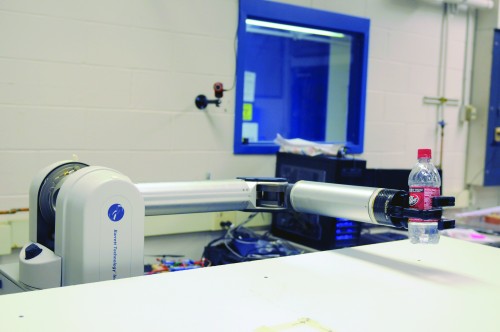 A ROBOT, CREATED BY PROFESSOR TRINKLE AND TEAM, MOVES a Dr. Pepper Bottle.
A ROBOT, CREATED BY PROFESSOR TRINKLE AND TEAM, MOVES a Dr. Pepper Bottle.As robotics has entered professional fields across the board, various fundamental problems have arisen. Professor of Computer Science Jeff Trinkle, along with several others from RPI to Germany, is conducting research to attempt to resolve such issues. In particular, Trinkle—who has years of experience with the topic—is addressing the area of grasping objects.
Trinkle has two main areas of focus. The first is learning more about how robotic hands work and trying to make them function more like human hands. The goal, he said, is to develop hands that can grab objects more precisely and securely. Trinkle hopes the efforts of various members of RPI will result in hands that can work together to assemble things or perform other such actions.
The other focus is on the “simulation of robots that are contacting things.” It is much more difficult, Trinkle mentioned, to get a robotic hand to perform a task than a human. “Take that pen for example,” he said. When taking off the cap, humans just do it. With robots, you have to be much more precise. “You would have to tell the robot to squeeze the pen and cap on both sides with, say, one pound of force, and pull them apart with two pounds.” Trinkle emphasizes the idea that programmers and designers have to predict, with a high degree of accuracy, how the robot will react to the object it is attempting to grasp.
This problem of getting a robotic hand to grasp things satisfactorily is what Trinkle refers to as the Grasp SLAM problem, standing for simulation, localization, and manipulation. As Trinkle mentioned, when a robot picks up an object, it has to know rather precisely where it lies in its hand and how the object is oriented. This requires a dynamic process involving a competent physics engine and various sensors (e.g. tactile, vision, and joint-angle). Along with a professor from the University of Albany, Trinkle intends to design a robot which utilizes a Bayesian controller, allowing for real-time tracking of how an object moves during the grasping process. With a combination of the physics engine, sensors, and controller, Trinkle and his team hope to develop robotic hands that can simultaneously determine where each piece of the process is located, manipulate the “finger” of the hand, and determine parameters of the object, such as weight.
The bigger picture, Trinkle says, is the movement by the National Robotics Initiative toward transitioning from “Robotics 1.0” to “Robotics 2.0.” The former refers to robots that already exist in industry to perform actions such as building cars and subsequently painting them. These robots require humans to manipulate the environment to satisfy its needs. Robotics 2.0, though, refers to robots that are able to adapt to the environment in which they are placed while still fully performing their jobs. These robots would be able to perform tasks that help the military, households, projects in space, and industries that still require assistance from humans.
However, Trinkle mentions, this presents the task of designing robots that can complete these jobs in a safe manner to the point that humans and robots would be able to interact with one another. Trinkle and his partners hope their research will be able to help the robotic community make headway into this technological frontier.
